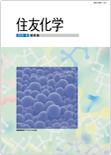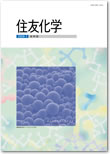FY 2008
vol. 2008 - II (2008.11.28 issue)
-
Pluto® MC is a new concept insecticide which was developed by Sumitomo Chemical Co., Ltd to control mulberry scale on tea during winter dormancy (from January to March). This formulation is a self-burst type of micro capsule formulation containing 9% of pyriproxyfen to reduce the risk of drift when it is sprayed in the tea field. Dormant spray of this formulation can show good control efficacy against the mulberry scale for a long-term period and can greatly reduce the risk of toxicity to the silkworm at the same time. Also, it is promising for farmers as a new labor-saving technique. Moreover, this insecticide is suitable for integrated pest management (IPM) programs. In this report, the development of Pluto® MC is described focusing on its basic performance against the mulberry scale, formulation design, optimum application timing and efficacies.
(by Shinji ISAYAMA,Naoki TSUDA )
-
We have been trying to apply environmentally benign organocatalysts to the synthesis of various kinds of pharmaceutical compounds. We herein report a practical synthesis of (3R,3aS,6aR)-hexahydrofuro[2,3-b] furan-3-ol (BFOL), a key building block for HIV protease inhibitors. The route is based on an enantioselective proline catalyzed direct cross-aldol reaction between aldehydes.
(by Tetsuya IKEMOTO,Yosuke WATANABE )
-
Oxidative polymerization of phenolic monomers and cross coupling polymerization of asymmetrically functionalized monomers are described as the precession synthesis for aromatic polymers controlled by transition metal catalysts. New methodologies, namely radical-controlled oxidative polymerization of phenols with high regioselectivity and asymmetric oxidative coupling polymerization of naphthol derivatives with high stereoselectivity have been developed. For Kumada-Tamao type and Suzuki-Miyaura type cross coupling polymerization, not only the head-to-tail selectivity has been regulated, but also catalyst transfer polycondensation has converted polymerization growth mechanism from stepwise growth type into chain growth type.
(by Hideyuki HIGASHIMURA,Masaaki KUBOTA,Kazuei OOUCHI,Daisuke FUKUSHIMA,Kenta TANAKA )
-
Structure determination from powder X-ray diffraction data (SDPD) has been developing dramatically. A large amount of SDPD work is reported in the field of crystallography and material science. However, SDPD is not easier than that from single crystal X-ray diffraction data due to intrinsic overlap reflections in powder XRD data. In this report, SDPD of Bicalutamide form-I and form-II is performed by the Rietveld refinement in combination with density functional theory (DFT) calculations. The effectiveness of the DFT optimization for SDPD is discussed.
(by Masamichi INUI,Masafumi UEDA )
-
It is difficult to analyze synthetic polymers using mass spectrometry, because they have a very wide molecular distribution (Mw/Mn). But if we select a relatively low molecular species, we can obtain information on polymer structure by means of MS. In this paper we describe an analysis method for synthetic polymers by means of SEC/ESIMS (using q-MS), some analysis cases, and the problems of this method.
(by Yoshinobu TSUCHIDA,Keiko YAMAMOTO,Hiromi YAMADA )
-
FE (Fire & Explosion) Training has been carried out as a new practical training course for all core engineers at Sumitomo Chemical since January 2007. It aims to develop the engineers’ knowledge of safety and disaster prevention, and sensitivity to danger in the chemical industry so that they can complete safe and stable operations in all factories and safe work in all laboratories. The training curriculum makes them safely experienced the danger of fire and explosions. Every trainee will gain sure and practical knowledge supported by the experience.
(by Shinobu MARUNO )
vol. 2008 - I (2008.5.30 issue)
-
GaAs-based semiconductor devices have been widely used in the front-end part of wireless telecommunication appliances such as handy phones, in order to support very high-speed data receiving and transmission. This paper reviews the requirement for p-HEMT switch ICs for the control of multi-band/multi-mode handy phone set, the market demand for which is increasing, and the design/manufacturing technology of the epitaxial substrate for the p-HEMT.
(by Masahiko HATA,Takayuki INOUE,Noboru FUKUHARA,Tsuyoshi NAKANO,Takenori OSADA,Junya HADA,Yasuyuki KURITA )
-
Plastic foaming products (polystyrene, polyethylene and polypropylene) are used in various fields in items such as food-packaging materials, distribution packaging materials, automobile parts and construction materials. Each product has its own characteristics such as light weight, flexibility (cushioning properties), heat insulation properties and sound absorption properties, which depend on factors such as the resin properties and foaming processes in each application field. In automotive parts applications in particular, polypropylene foaming technologies and products are becoming the center of attention from the points of view of weight reduction and recyclability. In this paper, we review the novel polypropylene foaming/molding technologies and products for Sumiceller®, and give our consideration to the requirement of weight reduction for automobile parts.
(by Jinsho NAMBU,Tomoo HIROTA,Akira UOTANI,Yoshinori OOMURA,Akinobu SAKAMOTO )
-
Ecotoxicological risk assessment of pesticides in aquatic ecosystems has become one of the most important areas of scientific pesticide evaluation. Sumitomo Chemical has been developing many pesticides in order to maintain a stable worldwide food supply, and we have been conducting high quality ecological risk assessments by using state-of-the-art techniques for the evaluation of our pesticides. In this article, the outline of the aquatic ecological risk assessment procedures in Japan, the USA and the EU are briefly summarized and some examples of sophisticated higher-tier ecotoxicological studies undertaken to demonstrate that our pesticides are benign to aquatic environment are introduced.
(by Mitsugu MIYAMOTO,Hitoshi TANAKA,Toshiyuki KATAGI )
-
In recent years the spread of ICP-MS has been remarkable because of high equipment sensitivity and progresses in collision / reaction cell technology. However, direct analysis of gaseous samples is not yet possible because of the difficulty of maintaining plasma during direct analysis. We have developed a gas converter which can move particulate matter included in gas samples to argon in order to now make direct analysis of gas samples possible. Using this new technology, real-time multi-element monitoring of airborne particulate matter samples was continuously examined by directly introducing an outdoor air sample via a PFA tube, and the signal intensities of 20 elements (40 isotopes) were measured at every 8 minutes for 80 hours. As a result, the signal intensities of Be, Ag, Cd, Sn, Sb, Tl, Pb, Bi, Th, and U were obtained at various instances.
(by Kohei NISHIGUCHI,Keisuke UTANI )
-
Low level quantities of PCBs were mixed into insulating oil used in electrical machinery, mainly transformers, as recognized by the Japanese government in 2003, however production and use of PCBs has been prohibited since 1973. The necessity of testing approximately several million transformers for PCB contamination has stimulated urgent interest in development of measurement techniques. We report the performance of our developed rapid and simple immunoassay system for the detection of polychlorinated biphenyls (PCBs) in transformer oil.
(by Katsuya IMANISHI )

